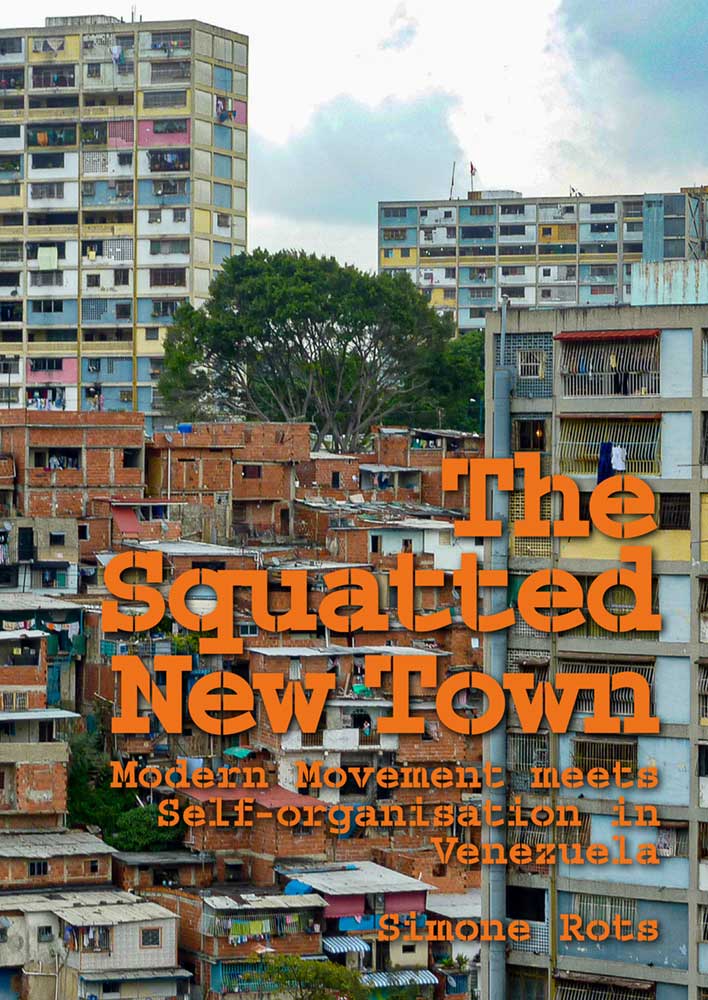
On the 6th of January 2021 Simone Rots defended her PhD research “The Squatted New Town, Modern Movement meets Self-organisation in Venezuela” at Delft, University of Technology. She has completed this research at the Department of Urbanism of the Faculty of Architecture, with Han Meyer as promotor, Remon Rooij as co-promotor and Ana Maria Fernandez Maldonado as daily supervisor.
This is the text of her laymans talk that explains the content of the research and defines which lessons can be learned from dissertation for the current and future practice of urbanism.
1/2
“The Squatted New Town, Modern Movement meets Self-organisation in Venezuela”.
The term Modern Movement is used in this research to address the new ideas on urbanism from the first half of the 20th century that culminated in the post war era and which opted for functionality, order, zoning with defined places to live, work and recreate, and amongst others was implemented as high-rise buildings in open spaces.
The definition of Self-organisation, used in this research, is urbanisation not planned by professionals
Self-organisation is in this way the opposite of planned. Modern Movement can be considered as top down planning and this research addresses the meeting point of these two.
3.
The topic of my research stems from the project “New Towns on the Cold War Frontier”, a research and book in process carried out by my office, Crimson Historians & Urbanists. This project examines, from a historical, cultural and political perspective, a series of completely new cities from the post-war period (1945-1980). By unravelling case studies from all parts of the world, the fascinating story of new towns and their social and political ambitions during the Cold war period unfolds .

4.
We (our office) divided the continents among us and when I studied Latin America my curiosity for an urban model in which planning and self-organisation can be combined came into being and when I analysed these new towns from the 1950s and 1960s situated in Venezuela: 23 de Enero near Caracas and Ciudad Guayana in the eastern part of Venezuela, it became clear to me that they could tell a story on the meeting point of formal planning and informal self-organised urbanisation.
5.
The opportunity of working on this topic by completing a PhD at the TU Delft was an offer I could not resist. When, during the research process, I started working at the International New Town Institute, also the co-funder of this PhD, I was increasingly assured that the results of the research could be an addition to the discourse of today. The current urbanisation questions are, in many ways, similar to the questions from the post-war era in Venezuela. I became more convinced to find out what lessons can be learned.
This led to the main research question:
Which lessons can be learned from the urbanisation in Venezuela in the 1950s and 1960s for the current and future urbanisation debate? And that I have answered using the following research design:
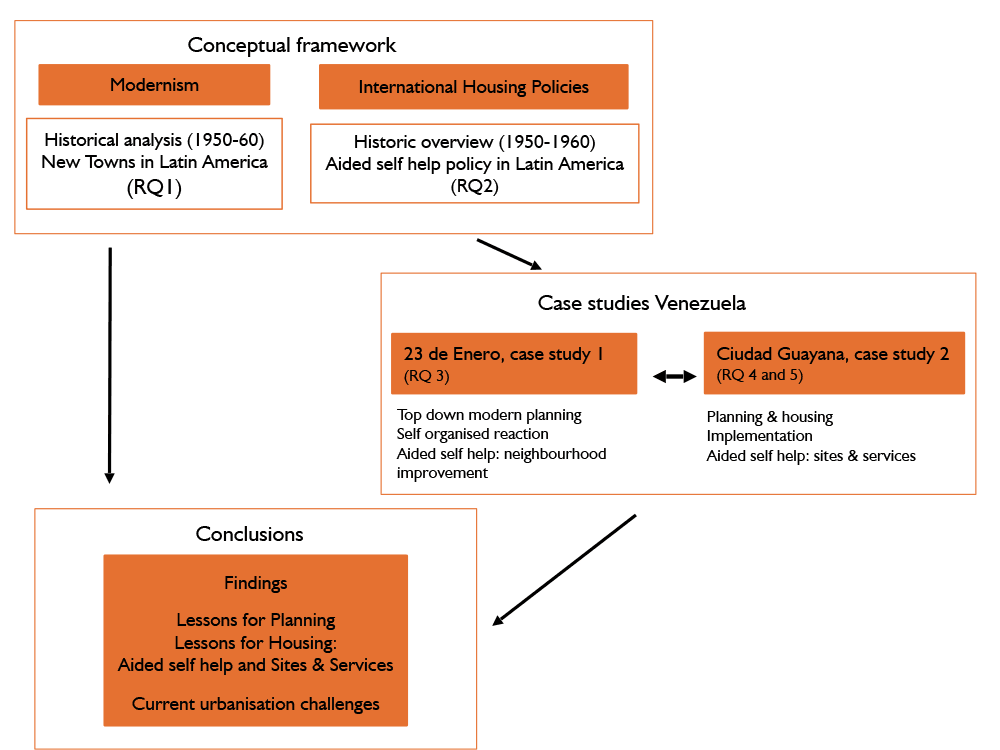
6.
I’m not going deep in to this scheme, but it shows that I studied modernism and international housing policies in Latin America in the 19502 and 1960s and that I have used case-study research as research method. This all led to the conclusions with findings and 14 lessons that can be an inspiration for finding an answer to the current urbanisation questions.

7.
So, the 1950s and early 1960s were a period of great economic dynamics and demographic change In Latin America. Cities were growing fast due to migration, which caused rapid urbanisation and a growing need for shelter. In this context, modern new towns and city expansions became an important task of governments, while modernising their countries and the ideas of the Modern Movement, played an important role in this. This resulted in a building boom in the Latin American region and the ideas of the Modern Movement like shown on the image on the left corner above, the Plan Voisin of Le Corbusier became reality in a short period of time, like you can see in the examples of Mexico City, Brasilia and 23 de Enero in Venezuela
8.
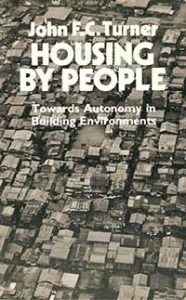
But these modern high-rise housing buildings could not cope with the rapid urbanisation and migration, the top-down planned new towns as icons of modernity, first promoted as the urban solution, were confronted with the increasing shortage of shelter. In response, international housing policies were promoted from the 1950s onwards with a focus on aided-self-help (a policy in which planning and self-organisation is combined) as an attempt to integrate the capacity of the growing number of new residents to build their own house. I researched this policy and traced it back to its origins because this policy could be the model that I was looking for. It became in the 1960s part of the international discourse and was promoted by for example John Turner, who worked in Peru and brought the topic into the academic world.
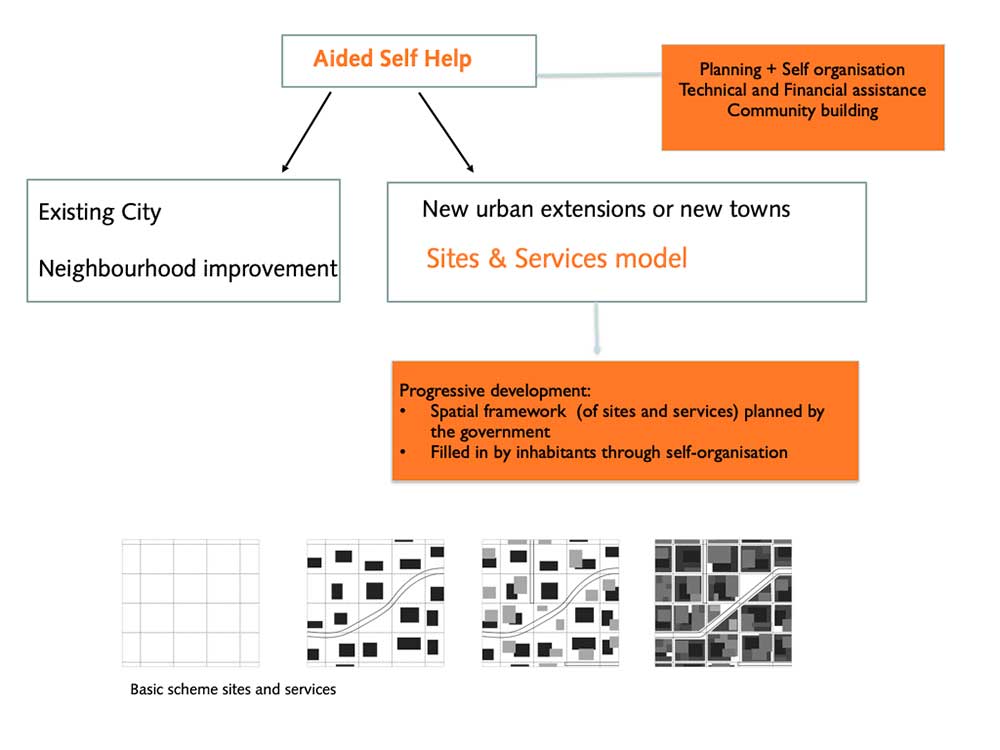
9.
Aided self-help is based on planning and self-organisation and important is the Aided part in this term, that refers to technical, financial assistance and assistance in building up the community, which is the responsibility of the committed government or landowner. Two types of aided self-help can be identified, for the existing city which uses neighbourhood improvement and for the new towns that uses as an important instrument the sites &services scheme. This scheme is based on progressive development and consists of a spatial framework planned by the government, that can be filled in by inhabitants through self-organisation.
10.
Why case-studies from Venezuela?
This is because the discovery of oil in Venezuela since the 1920s led to –for Latin America- unusually opportunities in modernising the country. The modernisation of the country meant the modernisation of the cities. The national government of Venezuela got through the oil economy sufficient financial means to realise ambitious urban development plans, in which modernist architecture and urban planning had an important role. This is unlike other countries in the Latin American region in that period of time, but in many ways similar to the urbanisation processes of today.
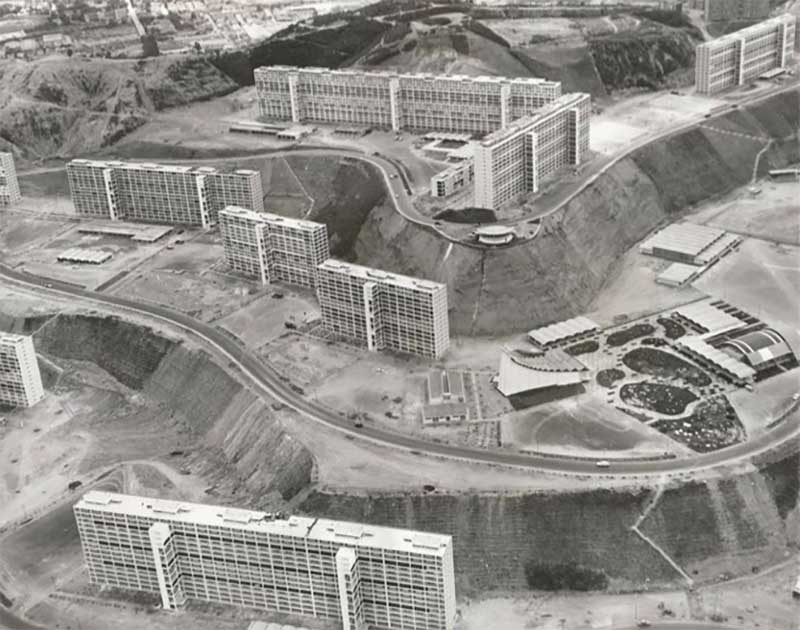
11.
One of the most important symbols of this modern urbanisation in Venezuela was the superblock inspired by the l’Unite d’Habitation of Le Corbusier. A team of which Carlos Villanueva, who was an important and influential architect in Latin America at that time, was the leading-architect, got the assignment to give an answer to the rapid urbanisation. Following the ideas of the modern movement, the superblock was developed and built early in the 1950’s through mass-production. It is top down planned, and the final version of 15 storeys high building could be built in 42 days.
The case study 23 de Enero consisted of 38 of these superblocks and was planned and built for 60 thousand new residents.
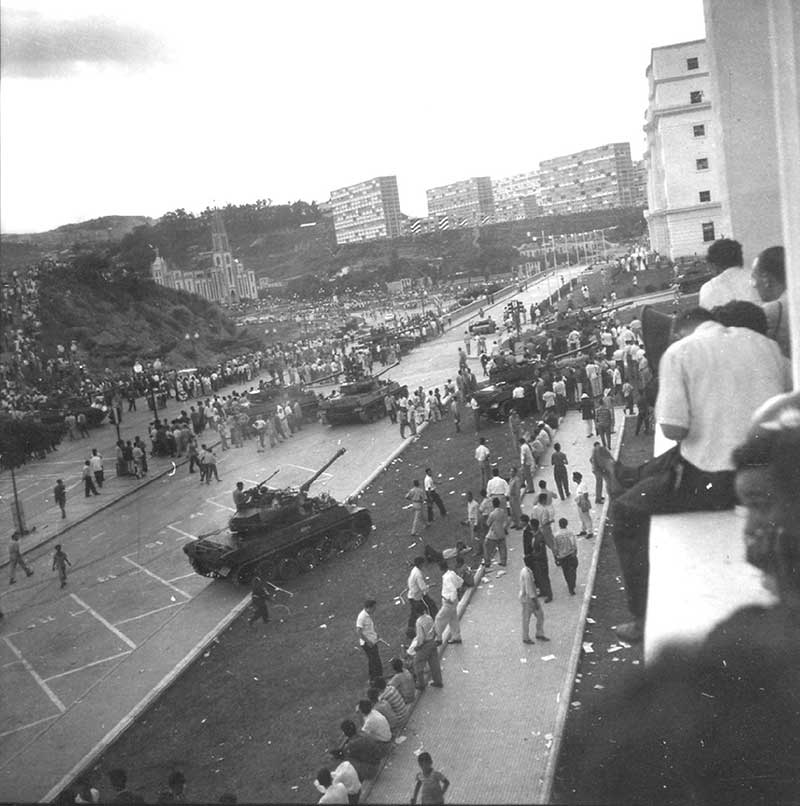
12.
23 de Enero is the most outspoken example of urban modernism that occurred in social housing in the 1950s in Latin America and it became for a short time the icon of the Modern Movement in Venezuela. When President Perez Jimenez, who initiated and stimulated this new town, was overpowered by a revolution on the 23rd of January, 1958, the new town was literally squatted by low-income population, while an informal settlement nestled in and around the blocks at an evenly rapid pace. 23 de Enero represents in this way the confrontation of top down modernistic planning with the reality of the rapid urban migration: the modernistic new town was confronted with self-organised urbanisation in an extreme way.
13 + 14.
Then the other case study, Ciudad Guayana, shows the efforts to combine the modernistic ideas and ideals with the economic driven reality of Venezuela. Ciudad Guayana was planned and built using the lessons of 23 de Enero, which means a.o. no more superblocks. It was supposed to become the new industrial capital of the country, the region provided other natural sources, so the city was an important element in a broader strategy of national economic planning in the 1960s.
The uniqueness of the planning history of Ciudad Guyana is that it was the result of a collaboration of planners from the United States, from the Joint Center for Urban Studies of Harvard University and MIT, and local Venezuelan professionals working for the Corporacion Venezolana de Guayana (CVG), a public agency which was also responsible for the development of the Guayana region.

15.
Both the planners from the Joint Center and the CVG shared the assumption that new planning approaches could provide solutions to the social and economic problems experienced in Venezuela. In such context, Ciudad Guayana can be considered as an urban laboratory that would test the main ideas of international planning during the early 1960s. During the research I became more and more aware that especially the planning process of Ciudad Guayana could provide me more insights, because next to different types of planning also the supply of sufficient affordable housing was tested. Some professionals of the planning team recognised the fact that informal self-organised urbanisation is part of the development of a new town and should be integrated in the planning process.
16.
Donald Appleyard one of the members of the Joint Center said “Ciudad Guayana was many cities in one”.
And already in its origins the new town was planned incorporating two settlements San Felix a fisherman’s village, which was based on self-organisation and Puerto Ordaz ,a small modernist new town from the early fifties, designed by Josep Llius Sert. In addition, a linear structure was the central concept of Ciudad Guayana with a long-side this central spine different neighbourhood units in which different planning approaches were tested.

17.
This characteristic of Ciudad Guayana was emphasized by the housing program that was incorporated in the planning process. A housing program for all income groups that was built through different neigh bourhoods scattered throughout the city.
Through demonstration projects and experiments this housing program started already before the final masterplan for the city was developed. For example, the Unidad Vecinal 4, neighbourhood 4 for higher -middle class income groups. Next to the planned neighbourhoods, like UV 4, also pilot projects with aided self-help and the sites and services schemes were implemented as answer to the fast growing informal settlements. El Gallo, part of one of the demonstration projects, is such a neighbourhood and this was a one of the clear examples of the implementation of the aided self-help policy in which planning and self-organisation was combined with the use of sites & services scheme.
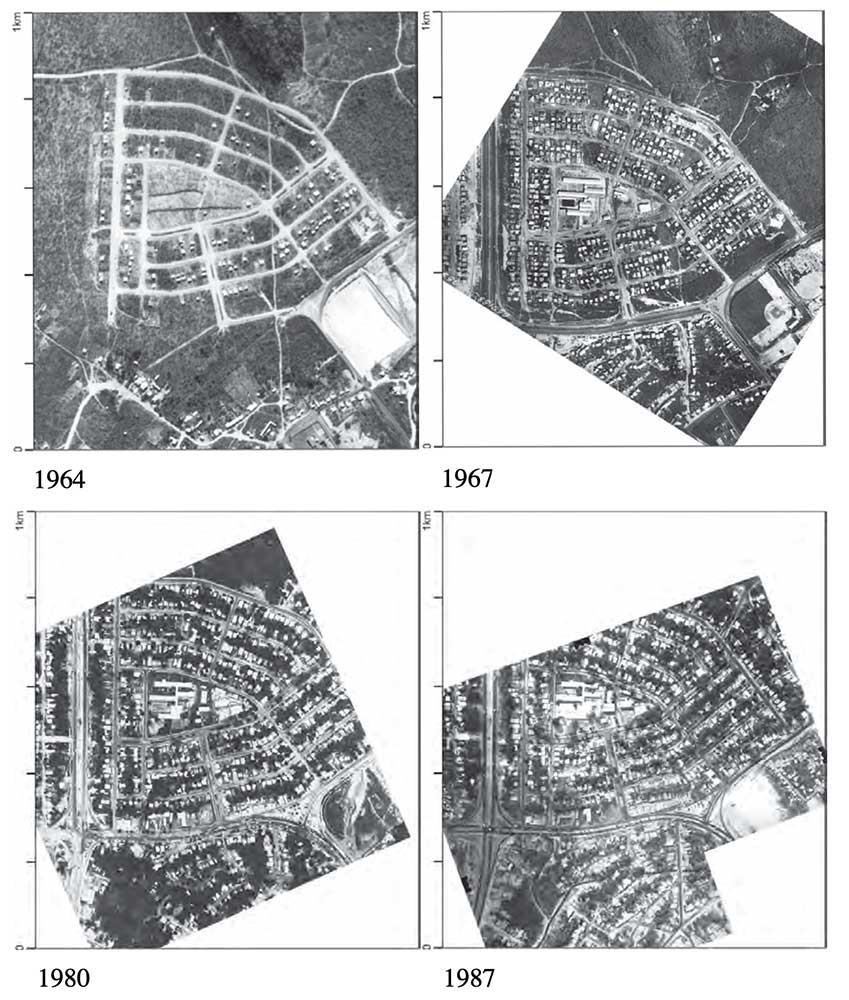
18 +19.
El Gallo is also based on progressive development. This means that the inhabitants could built on a plot that was part of a sites & services scheme and they could built whenever they have money or materials. The inhabitants were assisted by the government to build a house with financial and technical help and a community building initiative was started by the government. One year after the start in 1964 all plots were occupied and through self-organisation not only the filling in of the plots took place, but also the services (like water, sewage and electricity) and public facilities were built in a self-organised way with the assistance of the CVG.
Some residents started also small businesses at their plot which led to the strengthening of the social structure and offered the residents the possibility to improve their income.
The difference of El Gallo in the 1960s and El Gallo at a more recent date is clear.
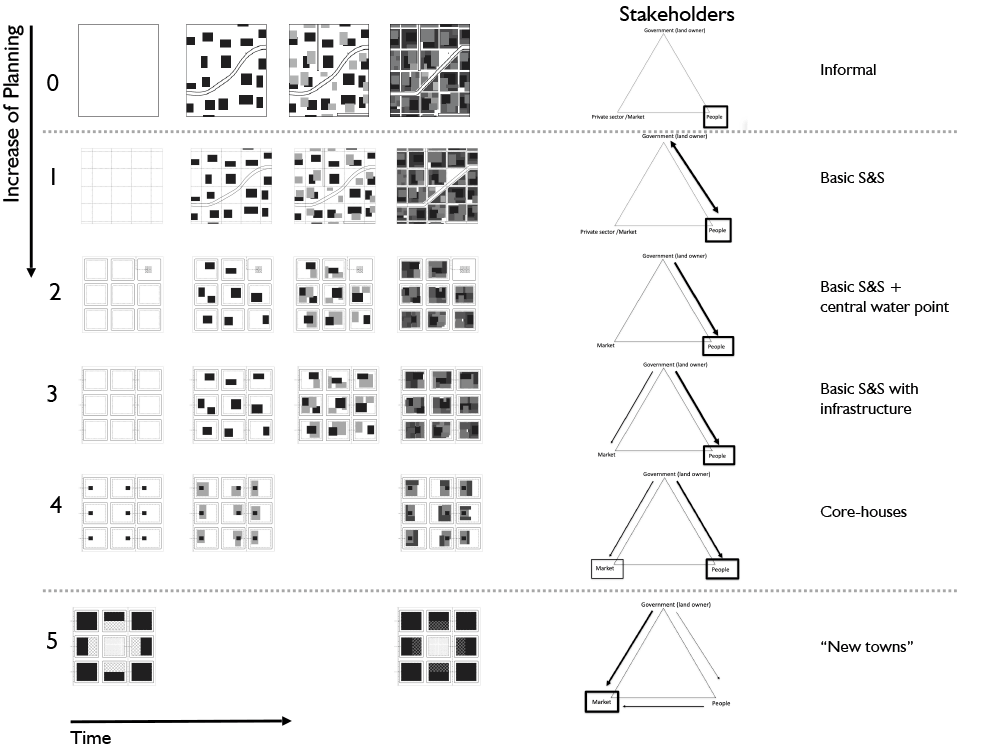
20.
The sites & services scheme as the core of aided self-help for new urban extensions or new towns can be identified in several types, in which the focus is not on the dwelling unit itself, but on the way the plots and facilities (sites & services) are planned.
This diagram shows a typology of sites & services schemes, according to the role of planning and their spatial evolution in time. It shows the effects of increased planning of the neighbourhood and the role of the different stakeholders depending on how much is planned and designed in advance.
From informal urbanisation with no sites or services, on the top, to a totally planned type that resembles a new town that is top down planned.
21.
This brings us to the Conclusion part of the Research Design, like I explained in the beginning. The research has produced innovative insights and 14 main lessons as an answer to the research question. The lessons are thematically divided in five lessons that focus on the urban planning process and eight lessons that address, specifically, the aided self-help policy with the sites & services scheme. The final, more reflective lesson regarding historic research is the basic lesson of this research, to my opinion.
22.
One of the lessons for planning is for example that informal urbanisation requires the use of flexible and adaptive planning approaches, saying this is already stating that informality is part of the planning process. And this brings us to another lesson, the planning process of a new town should include an affordable housing program, so housing for all income groups will be available.
An important lesson addressing aided self-help is that a committed, strong and well-organised government is needed for the success of aided self-help. Next to that it is important to realise that there is not an ideal type of sites and services, it depends on the amount of planning, time and the different stakeholders involved.
The final lesson is the basic lesson of this research linking historical analysis to today’s urban questions and challenges

23-24-25.
During the research period, I had the opportunity to make this link with the current urban questions through my work at INTI, the International New Town Institute. I started to use the gained knowledge on aided self-help and sites & services schemes during three so called New Town Labs that were organised both by INTI and the TU Delft.
During these intensive urban planning workshops I was able to show what the potential use and application of the lessons could mean for the new towns that are developed at this moment.
Like in Mahonda in Zanzibar, a village of 1700 inhabitants, that will grow rapidly in the near future. And also Tatu City Kenia, a new town near Nairobi planned and built by developer Rendeavour with a target population of 150.000 residents and Caximba ,an informal city extension of Curitiba in Brazil.
The insights from these exercises needs further research so there is much left to do.
26.
Finally, I want to say that this research is not just a historical analysis of modernism and aided self-help in the 1950s and 1960s, but can be placed in a long tradition of discussion and international discourse regarding modernistic new town planning. The results of the research positioned within this ongoing discourse, should not be considered as an encouragement of urban informality or self-organisation as the opposite approach of modernism. Instead, it shows the opportunities of a policy that could give an alternative within the habitual use of modernistic ideas and concepts within new town planning. The analysis of the implementation of the aided self-help policy in the Venezuelan cases has provided lessons that can be shared within the current practice of new town planning.
Lessons that integrate the needs and wishes of the residents, and emphasize the importance of the commitment of the authorities, policy makers and project developers.